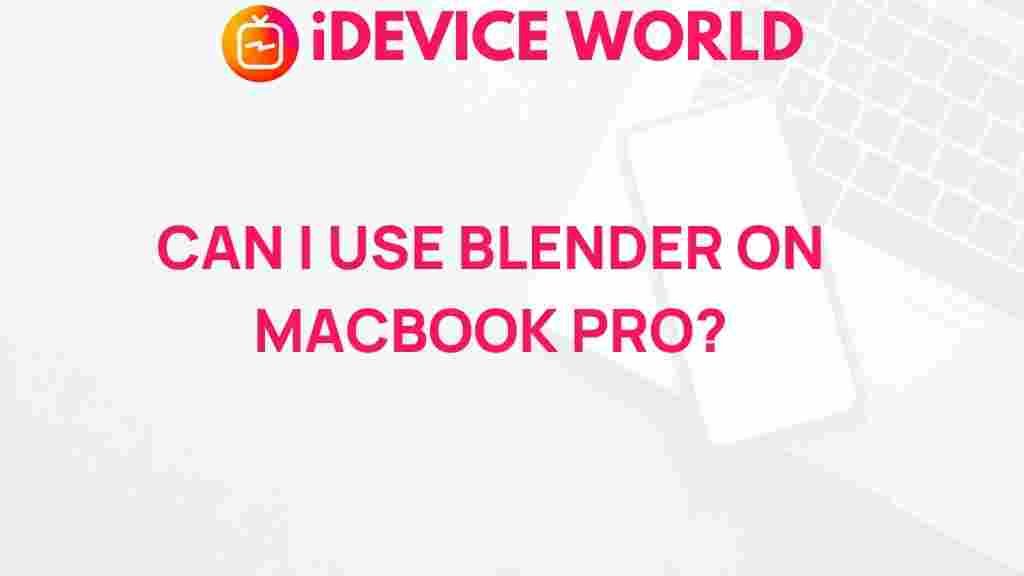Unleashing the Power of Blender on MacBook Pro
Blender is an open-source 3D creation suite that has gained immense popularity among artists, animators, and developers alike. Whether you’re a beginner exploring the world of 3D design or a professional working on complex animations, Blender provides a robust platform to unleash your creativity. In this article, we will explore how to maximize the power of Blender on a MacBook Pro, providing tips, tools, and techniques to enhance your workflow.
Getting Started with Blender on MacBook Pro
To harness the full potential of Blender, you first need to install it on your MacBook Pro. Here’s a step-by-step guide to help you get started:
- Visit the Official Blender Website: Go to the Blender download page and choose the Mac version.
- Download the Application: Click on the download link, and the installer will be downloaded to your computer.
- Install Blender: Open the downloaded file and drag the Blender icon into your Applications folder.
- Launch Blender: Navigate to your Applications folder and double-click on Blender to start using it.
After installation, familiarize yourself with the interface. Blender has a steep learning curve, but with practice, you will find it to be a powerful tool for your projects.
System Requirements for Optimal Performance
To ensure that Blender runs smoothly on your MacBook Pro, it’s essential to meet the system requirements:
- Operating System: macOS 10.13 or later.
- Processor: Intel or Apple Silicon (M1 chip recommended).
- RAM: Minimum of 8GB; 16GB or more is preferred for complex projects.
- Graphics: A GPU that supports OpenGL 3.3 or higher.
- Disk Space: At least 1GB for the application, plus additional space for projects.
Setting Up Blender for MacBook Pro
Once you have installed Blender, the next step is to optimize your settings for better performance:
- Configure Preferences: Go to Edit > Preferences. Here, you can adjust settings such as the user interface theme, input preferences, and system performance settings.
- Set Up Keyboard Shortcuts: Familiarize yourself with Blender’s shortcuts to speed up your workflow. You can customize them in the Preferences menu under Keymap.
- Enable Auto Save: To prevent loss of work, enable the auto-save feature under Preferences > Save > Auto Save.
Creating Your First Project in Blender
Now that your environment is set up, let’s dive into creating your first project:
- Create a New File: Start a new project by clicking on File > New.
- Add Objects: Use the Shift + A shortcut to add new objects to your scene. Experiment with different shapes like cubes, spheres, and planes.
- Transform Objects: Use the move (G), rotate (R), and scale (S) tools to manipulate your objects.
- Apply Materials: Select an object, go to the Material Properties tab, and create new materials to apply textures and colors.
- Lighting and Rendering: Add lights to your scene for better visibility. Use the Render tab to set up your camera and render settings.
Using Blender’s Powerful Features
Blender is equipped with a plethora of features that can elevate your projects:
- Modeling: Utilize various modeling techniques such as sculpting, retopology, and modifiers.
- Animation: Create keyframes for animating objects. Blender’s Grease Pencil tool allows for 2D animations within a 3D environment.
- Physics Simulation: Implement realistic simulations for fluids, smoke, and rigid bodies to add dynamic elements to your projects.
- Compositing: Use Blender’s built-in compositor to add post-processing effects to your renders.
Troubleshooting Common Issues on MacBook Pro
As you work with Blender, you might encounter some common issues. Here are some troubleshooting tips:
- Performance Lag: If Blender is running slowly, try reducing the viewport shading settings or enabling simplified geometry in the display settings.
- Crashes: Ensure that your MacBook Pro meets the required specifications. If crashes persist, consider reinstalling Blender or updating your macOS.
- Missing Add-ons: If certain features or add-ons are missing, check if they are enabled in the Preferences under the Add-ons tab.
- File Compatibility Issues: Ensure that you save your projects in a compatible format, especially if you are sharing files with other users.
Exploring Blender’s Community and Resources
To enhance your Blender skills, it’s beneficial to engage with the community and utilize available resources:
- Official Documentation: The Blender Manual is an extensive resource for learning the ins and outs of the software.
- Online Tutorials: Websites like YouTube and Blender Guru offer countless tutorials ranging from beginner to advanced levels.
- Community Forums: Join forums and groups such as Blender Artists and Reddit’s r/blender to connect with other users.
Conclusion
Blender is an incredibly powerful tool for 3D creation, especially on a MacBook Pro. By following the steps outlined in this article, you can unleash the full potential of Blender and create stunning projects. Remember to explore the various features, engage with the community, and continually learn to enhance your skills. Whether you are a hobbyist or a professional, Blender offers the tools you need to bring your creative visions to life.
Start your journey with Blender today, and let your imagination take flight!
This article is in the category Guides & Tutorials and created by iDeciveWorld Team

1 thought on “Unleashing the Power of Blender on MacBook Pro”